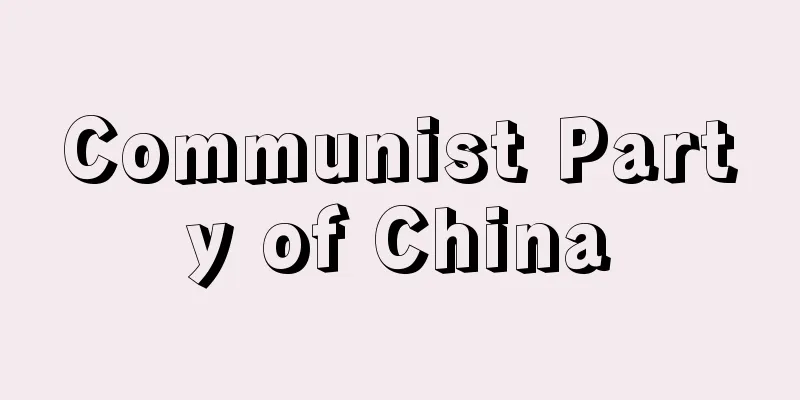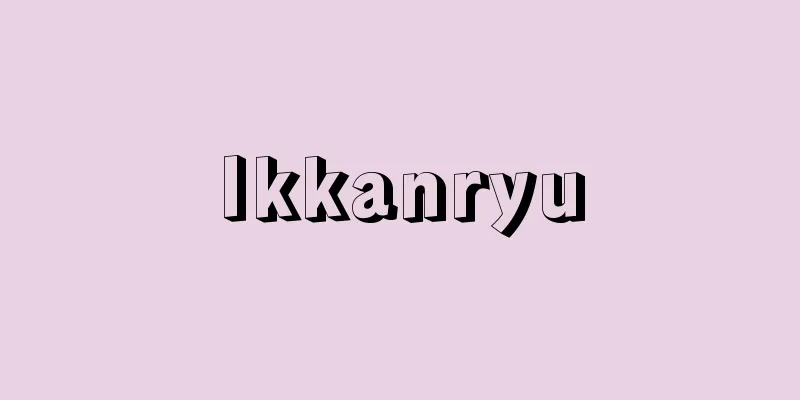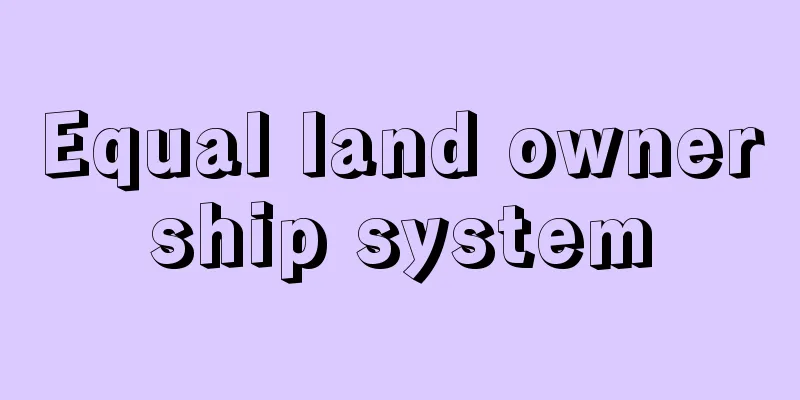Communist Party of China

|
The ruling party of the People's Republic of China. Founded in 1921, it won a struggle against the Kuomintang and established power in 1949. The party has 89,447,000 members (2016). The most authoritative party is the National Congress (Party Congress), held every five years, which is made up of 2,000-3,000 party representatives, including provincial representatives and party representatives from national institutions such as the State Council and the People's Liberation Army, as well as mass organizations. The Party Congress decides on important basic party policies and elects members of the Central Committee (around 200 people) who decide on important matters when the Party Congress is not in session. The Central Committee also elects members of the Central Politburo (25 members as of November 2017). The Politburo meetings are the de facto policy-making body, and important policies are routinely discussed and narrowed down in the Central Leading Small Groups for each field (for example, the Central Leading Small Group for Foreign Affairs in the field of diplomacy, and the Central Leading Small Group for Finance and Economics in the field of economy and finance), and then deliberations and decisions are made based on these. At the core of the Politburo is the Standing Committee (with seven members as of November 2017), headed by the General Secretary of the Party. [Amako Satoshi April 18, 2018] OverviewAccording to the "Constitution of the Communist Party of China (Party Constitution)," the party is the "vanguard of the working class" that upholds Marxism-Leninism and Mao Zedong ideology and aims to realize communism, and is composed of outstanding workers, farmers, soldiers, and intellectuals. However, since 1978, when the party began to push forward with reform and opening up and economic modernization, emphasis has been placed on building a "prosperous and strong China," and for this purpose, it was no longer sufficient to have only workers, peasants, soldiers, and revolutionary intellectuals as members. Therefore, in order to respond to the new era, it became necessary to propose a change in the positioning of the Communist Party itself. In February 2000, General Secretary Jiang Zemin came up with a new definition, known as the "Three Represents Theory" (see below), which was officially adopted as the party's official thinking at the 14th Party Congress in the fall of the same year. This led to the participation of private business owners with outstanding achievements, high-tech industry managers, and highly educated experts in the party. The Communist Party is no longer a class party but a national party, or to put it bluntly, a "party of the elite." It is no exaggeration to say that it has completely changed its character. Its main mission has also changed from the realization of revolution and communism to nationalistic claims such as "the realization of a prosperous and powerful China" and "the great rejuvenation of the Chinese nation." Despite the global trend of the decline of communist ideology and the collapse of the Communist Party around 1990, the Communist Party of China continued to reinvent itself, and the number of party members continued to increase. At the time of the founding of the country, the party had 4.5 million members (0.8% of the total population at the time), but at the end of 2016, the number had exceeded 89,447,000 (an increase of about 670,000 from the previous year). In this way, the Communist Party of China became the largest political party in the world (for reference, at the end of 2012, the Republican Party in the United States had 31.3 million members and supporters, and the Democratic Party had 43.51 million). Even now, there are almost no political organizations in China that can compete with the Communist Party, and the Communist Party continues to hold real political power with its overwhelming presence. [Amako Satoshi April 18, 2018] historyFrom the Founding of the Party to the Founding of the People's Republic of China (1921-1949)The Communist Party of China was founded in 1921 as the Chinese branch of Comintern, led by young people inspired by the patriotism of the May Fourth Movement of 1919 and under the guidance of the Soviet Union and Comintern (an abbreviation for "International Communism," also known as the Third International). This was a time when the First World War had ended, the communist state of the Soviet Union had been born, and anti-imperialist and anti-colonial movements were spreading throughout the world. The party's goal was to save "semi-feudal, semi-colonial China" and realize a communist society in China in the future. It would later follow a winding path along with the Chinese Revolution, while being strongly influenced by the Soviet Union. Shortly after the party was founded, the Soviet Union asked for cooperation with the Chinese Kuomintang, the largest revolutionary party at the time. Under the guidance of the Soviet Union and Comintern, the Kuomintang was reorganized into an organization modeled on the Communist Party of the Soviet Union, and set the slogan "Alliance with the Soviet Union, Support of the Communist Party, and Support of the Workers and Peasants." In 1924, members of the minority Communist Party joined the Kuomintang while retaining their party membership, and the First Kuomintang-Communist Cooperation was realized. In March 1925, Sun Yat-sen died, and Chiang Kai-shek, who came to power, began his Northern Expedition with the aim of conquering the whole country, but in April 1927, while on the way, he staged the April 12th Coup in Shanghai to wipe out the Communists. The First Kuomintang-Communist Cooperation collapsed, and an era of confrontation between the Kuomintang and the Communist Party began. The thorough oppression by the Kuomintang made it difficult for the Communist Party to operate in the cities, so they shifted their focus to expanding their rural bases, mainly in Jiangxi Province, using Mao Zedong's guerilla tactics. However, they were forced to retreat after three encirclement attacks by the Kuomintang army, and after a year-long "Long March," they reached Yan'an, north of Xi'an, where they used the area as a base to expand their influence again. Around the same time, Japan's invasion of the northeast and northern China intensified, and the anti-Japanese and national salvation movement spread among intellectuals and civilians. In December 1936, the Xi'an Incident occurred, in which Kuomintang general Zhang Xueliang, who had been driven out of the northeast, and others urged Chiang Kai-shek to "unite in the fight against Japan," and behind-the-scenes adjustments were made between the Kuomintang and the Communist Party. The July 7 Incident (Marco Polo Bridge Incident) in 1937 led to full-scale war between Japan and China, and the Second Kuomintang-Communist Cooperation was established. The war continued until Japan's unconditional surrender in August 1945, resulting in numerous tragedies including the Nanjing Massacre. In April of the same year, the 7th Communist Party Congress was held, where the term "Mao Zedong Thought" was used for the first time and became the guiding ideology of the Communist Party. At the same time, in opposition to the Kuomintang-led construction of a unified nation, Mao announced his "On United Government," which became the basic philosophy and framework for the founding of the People's Republic of China, which was realized four years later. [Amako Satoshi April 18, 2018] Mao era (1949-1976)In October 1949, after winning the Chinese Civil War, the Communist Party proclaimed the establishment of the People's Republic of China. The Communist Party's initial goal was to build a new democratic society that allowed ethnic political parties and ethnic capitalists to participate in the government. However, it soon began to push forward with building a socialist society, and the Chinese Communist Party eventually began to oppress non-Communist parties such as the Democratic League, becoming a party that monopolized the state. Furthermore, the Anti-Rightist Movement that began in 1957 strengthened the dictatorship of the Communist Party, and in particular Mao Zedong. The subsequent "Great Leap Forward" was Mao's own ambitious attempt to build socialism in opposition to the Soviet Union, but it ignored objective conditions and was too utopian, leading to economic chaos and the tragic deaths of over 36 million people from starvation (according to Yang Jizhang). With the failure of the Great Leap Forward and Mao's retreat from the front lines, the leadership of economic reconstruction was entrusted to Liu Shaoqi and Deng Xiaoping, and economic recovery began to see results through the practice of pragmatism known as the "white cat, black cat theory" (Deng Xiaoping's theory that "whether a cat is white or black, the one that catches mice is a good cat"). However, Mao Zedong saw this as a danger, calling it the "revival of the bourgeoisie," and launched the Cultural Revolution in the late 1960s, thoroughly attacking Liu Shaoqi, Deng Xiaoping, and the networks of people connected to them, once again plunging the economy into chaos. Widespread political repression further strengthened the dictatorial regime. Internationally, the Sino-Soviet dispute began in earnest in 1963, and during the Cultural Revolution, the Soviet Union was strongly criticized as revisionist and then as social imperialist, deepening the confrontation, which became so serious that the Sino-Soviet border conflict broke out in 1969. [Amako Satoshi April 18, 2018] Deng Xiaoping era (1978-1993)However, many people suffering from extreme poverty and political oppression began to voice growing calls for economic and political reconstruction. The first to speak out cautiously was Zhou Enlai, who proposed the "Four Modernizations" (a strategy to modernize industry, agriculture, science and technology, and national defense to reach a globally advanced level by the end of the 20th century), and it was the resurrected Deng Xiaoping who carried on his teachings. Deng was forced to resign again in the First Tiananmen Square Incident (1976) by the Gang of Four, including Jiang Qing, who considered himself the "successor" of Mao Zedong, who died in 1976. However, after the Gang of Four's downfall, Deng returned and engaged in a fierce power struggle with Hua Guofeng, who became Mao's successor, and at the Third Plenary Session of the 11th Central Committee in December 1978, he succeeded in shifting the country to a path of economic construction and modernization. He then settled the evaluation of Mao Zedong with a method called "3/7 Opening" (3/3 criticism, 7/7 evaluation), and boldly promoted "reform and opening up," including the creation of special economic zones to attract foreign capital and advanced technology, the promotion of an agricultural contracting system, and eventually the introduction of a market economy. However, Deng Xiaoping, who was already elderly, did not take on the highest leadership post (General Secretary of the Party) himself. Instead, he appointed Hu Yaobang as his successor as General Secretary of the Party and Zhao Ziyang as Premier of the State Council (Premier), and sought to promote reform and opening up through the so-called "troika system" in which he himself took a step back to provide overall leadership. In terms of political reform, several efforts were made, including the introduction of a retirement age for party and leading officials, and the devolution and decentralization of power. However, discussions of political reform touched on issues of party leadership and democratization, which increased political tensions and eventually led to the Second Tiananmen Square Incident in 1989. The incident was triggered by the death of Hu Yaobang, who was dismissed as General Secretary of the Party in 1987, and the calls for Hu's restoration of his reputation combined with students' demands for democratization, which became a widespread movement, creating a conflict within the Party over whether to support or oppress the students, leading to serious political turmoil. Deng Xiaoping chose to oppress the students, while General Secretary of the Party Zhao Ziyang supported them, and in the end Deng Xiaoping ordered the introduction of the military, which led to the suppression of the student movement and Zhao Ziyang's downfall. However, Deng wasted no time in declaring that "the reform and opening-up policy will not change," and worked hard to retain economic aid from the West. In particular, during the Chinese New Year in 1992, at the age of 88, he visited Shanghai, Shenzhen, and other cities to deliver a speech known as the "Southern Tour Speech," in which he called for an end to ideological debates and advocated a "socialist market economy." As a result, foreign investment recovered and the economy returned to high growth. [Amako Satoshi April 18, 2018] The Jiang Zemin Era (1993-2002)Deng Xiaoping's basic strategy after the Second Tiananmen Square Incident was "economic opening and political tightening," and he left the promotion of this strategy to Jiang Zemin. Jiang Zemin monopolized the top three powers of General Secretary of the Party, President of the State, and Chairman of the Military Commission, and strengthened the education of patriotic ideology. In charge of the economy, Zhu Rongji became Premier of the State Council and demonstrated his dexterity in tax reform and state-owned enterprise reform. In 2000, China's long-awaited accession to the World Trade Organization (WTO) was realized, foreign trade became active, the introduction of foreign capital accelerated, and economic growth proceeded at a pace far beyond the leaders' own expectations. In the midst of this, serious contradictions in the positioning of the Communist Party became apparent. The Communist Party had long been positioned as the "vanguard of the working class," but its policy of prioritizing economic development meant that its main force had to be entrepreneurs, engineers, and intellectuals with the latest knowledge, abilities, and technology. Thus, at the 16th Party Congress in 2002, the Party attempted to redefine itself, asserting its "three representatives": (1) advanced social productive forces, (2) advanced culture, and (3) the broadest interests of the people. It also added the phrase "it is the vanguard of the Chinese people and the Chinese nation." As a result, the Communist Party abandoned the concept of being a "class party" that it had long held on to, and became a "national party" and "ethnic party" in which entrepreneurs, highly educated intellectuals, and celebrities in the fields of sports and literature could join. [Amako Satoshi April 18, 2018] Hu Jintao era (2002-2012)The Hu Jintao era saw extremely smooth development in terms of numbers, and in 2010 China finally overtook Japan in terms of gross domestic product (GDP) to become the second largest in the world after the United States. The 2008 Beijing Olympics and the 2010 Shanghai World Expo were also successfully concluded, fully demonstrating China's presence to the world. However, when one peels back the surface and looks at the inside of China, one finds that the country is becoming increasingly characterized by a "sick society," including a widening gap between rich and poor, undemocratic policy-making, widespread corruption, and worsening environmental pollution in both the coastal and inland areas. In response, the Hu Jintao administration aimed to realize a "harmonious society," but failed to bring about any fundamental improvements. [Amako Satoshi April 18, 2018] Xi Jinping era (2012~)Xi Jinping, who succeeded Hu Jintao, came to power with the goal of realizing the "Chinese Dream" of "two hundred years of success." One is to realize a comprehensive moderately prosperous society (ensuring a decent standard of living) and catch up with the United States in GDP in 2021, which marks the 100th anniversary of the founding of the Communist Party. The other is to match the United States in overall national power and become a leading world nation in 2049, which marks the 100th anniversary of the founding of the People's Republic of China. The Xi Jinping administration is aiming to maintain the leadership of the Communist Party, stabilize the system, and realize the "great rejuvenation of the Chinese nation," and it seems as if the realization of a communist society has been all but forgotten. The Xi Jinping administration began by launching a thorough anti-corruption campaign, arresting and ousting party heavyweights Zhou Yongkang (1942- ) and Ling Jihua (1956- ), as well as People's Liberation Army heavyweights Xu Caihou (1943-2015) and Guo Boxiong (1942- ), and bringing down the leaders of opposing forces. These actions were cheered by the public, who were fed up with serious corruption. At the same time, they strengthened the Xi Jinping administration, whose power base was weak. Furthermore, Xi not only monopolized the top positions (heads and directors) of each of the Central Leading Groups, which had previously been responsible for policy discussions and proposals in various fields, but also established a new organization, the Central National Security Commission, which oversees domestic and international security, military affairs, foreign affairs, etc., and became its director, seizing control over almost every institution that constitutes power. In the People's Liberation Army, he also took action, such as reorganizing the "Four General Departments" such as the General Staff Department and the seven major military regions, further concentrating power in Xi's hands. The 19th Party Congress was held in November 2017, starting Xi Jinping's second term in power. The 6th Plenum of the 18th Central Committee of the Communist Party of China approved Xi Jinping as the core of the party, and the 19th Party Congress included the expression "Xi Jinping Thought on Socialism with Chinese Characteristics for a New Era" as a guideline for action in the party constitution. This has elevated Xi to a position of party leader on a par with Mao Zedong and Deng Xiaoping. Furthermore, the seven members of the Politburo Standing Committee, including Xi, and the 25 members of the Politburo are not faction-balanced, but are basically people who, with the exception of Li Keqiang and Han Zheng, have had close ties with Xi for a long time and who have consistently shown loyalty to Xi and contributed to strengthening the government since Xi became the top leader. When Wang Huning, who later became one of the Top Seven (Politburo Standing Committee members), emerged as a young star political scientist in the late 1980s, when debate over political reform was at its height, he argued that "China today needs an enlightened modernist dictatorship that is more strongly oriented toward modernization than toward democratization," and that a so-called neo-authoritarian dictatorship (a general developmental dictatorship) was necessary. This seems to be exactly what Xi Jinping is today. [Amako Satoshi April 18, 2018] Governing StructureParty-State RelationsThe Constitution stipulates that the National People's Congress (NPC), the legislative body, is the highest organ of power, but in reality, deliberations on important matters and basic policies are decided within the party (for example, the Central Politburo and the Central Committee). These proposals are submitted to the NPC for deliberation and decision-making, but this is generally considered to be a mere formality. As is well known, China today is a system in which the Communist Party has taken control of the state and society. To implement this system, it has created a detailed system of control, communication, and surveillance. This system involves the establishment of party committees and party groups (fractions) in every organization, including the government, the National People's Congress, and the courts, as well as in companies, factories, and schools, firmly penetrating the intentions and policies of the party leadership into every organization in society, and controlling the government and social organizations under the guidance of higher-level party organizations. On top of that, the party firmly controls the apparatus of violence, such as the military and public security, and further organizes propaganda departments from the center to the grassroots, controlling ideological fields such as newspapers, television, and social media. [Amako Satoshi April 18, 2018] Relations between the Central and Local PartiesIn the relationship between the central and local levels of the party, lower-level organizations can present various opinions and requests to higher-level organizations, but absolute obedience is required for policies decided by higher-level organizations (the so-called democratic centralism). However, in reality, while local organizations appear to obey the central government on the surface, they often act against the central government's will (this is known as "policies from above, measures from below" or "yang obeys yin and contradicts"). Typical examples of this include environmental pollution and rampant corruption caused by local governments in collusion with vested interest groups. For this reason, the Central Committee of the Party has made various attempts to firmly control the regions. In particular, the Organization Department of the Central Committee of the Party has been trying to control the personnel affairs of provincial and municipal leaders (the next level below the province level) by giving them sole control. Another attempt has been to shift the balance of power in terms of finances by concentrating tax revenues in the central government through tax reform. [Amako Satoshi April 18, 2018] Governance and the People/SocietyA dynastic-like system of governmentThere is a school of thought that regards the Chinese dynastic system as a "super-stable system." At the base was an economic structure (landlord economy, agricultural economy), and at the top was an ideological structure based on Confucianism and a huge bureaucratic structure directly connected to the emperor. The idea is that these three entities complemented each other in a mutually complementary manner, and thus, even if there were fluctuations, mechanisms of restoration and stabilization worked to dynamically maintain stability. During the Mao era, China was also basically a huge rural society, with an orthodox communist ideological structure at the top and a huge bureaucratic structure, including the National People's Congress system, the State Council, and the People's Government system, and the basic structure was similar to the traditional governing system of the dynastic era. Furthermore, the Communist Party, which had a nationwide organization and network, firmly controlled the ideology and bureaucratic system, so it can be interpreted as being a more powerful system than the traditional governing system. This is why the country did not collapse even when the economy was on the brink of collapse after the Great Leap Forward, or when the bureaucratic system was on the brink of collapse during the Cultural Revolution. [Amako Satoshi April 18, 2018] The people accept the party's ruleIn the relationship between the party and the people, the people generally accept the Communist Party system as a given, and there are not many cases where they challenge the system itself. However, in recent years, people have become aware of their own rights and interests, and they often protest and confront those who try to unjustly infringe on them. This is called the "rights restoration movement," and it is in conflict with the authorities' claim of "restoration," which emphasizes social stability. The same can be said about the injustice and corruption of local officials. In addition, an increasing number of non-powerful intellectuals, including students, are skeptical of the one-party Communist system, but due to their experience of being thoroughly oppressed by the authorities during the Anti-Rightist Movement, the Cultural Revolution, and the Tiananmen Square incident in the late 1950s, they are still afraid of the party, and only a very small number of people are willing to take overt action. By the way, all democratic parties other than the Communist Party combined only have a membership of just over 700,000 (as of 2007), which is nothing compared to the Communist Party, which has nearly 90 million members. [Amako Satoshi April 18, 2018] The reality of the power struggleFactions and connectionsDuring the Mao Zedong era and the transition of power to Deng Xiaoping, there were of course factions and conflicts within the Communist Party. These were manifested mainly in factional conflicts between the field military connections of the People's Liberation Army, which was formed by the unification of the four field armies, as well as conflicts within the party apparatus and the State Council between those who prioritized ideology and those who prioritized practical matters, and between those in favor of reform and those in favor of conservatives. Since the Jiang Zemin era, economic vested interests have emerged within the party and formed new factions. Representative examples include the oil faction, including Zeng Qinghong (1939-), Zhou Yongkang, and others; the coal faction, including Ling Jihua and others from Shanxi Province; and the electricity faction, including the Li Peng family. In addition to these factions, it is also common for connections to be made through the organization or region from which they originate. Some of the more prominent factions are the "Second Generation of Reds" (Princelings), whose parents are party officials; the "League faction" (Communist Youth League faction), which originates from the Communist Youth League; and the Shanghai faction, a faction formed by old Shanghai-born officials after the downfall of the "Gang of Four" during the Cultural Revolution. [Amako Satoshi April 18, 2018] The power struggle between Jiang Zemin, Hu Jintao and Xi JinpingWhen Mao Zedong and Deng Xiaoping were alive, they had the final decision-making power, so although they might attack a certain person through their will, there were rarely any open, fierce power struggles for other reasons. Jiang Zemin was praised for his suppression of the Shanghai democratization movement during the Second Tiananmen Square incident, and was selected for the top position at the behest of Deng Xiaoping. Although he had a weak political base and was the chairman of the Central Military Commission with no military experience, he strengthened his base by forcing his rivals into retirement one after another with the support of the Shanghai faction and Deng Xiaoping, and gradually placing the military leaders he selected for top positions. In order to avoid political exhaustion through power struggles, Deng Xiaoping had nominated Hu Jintao as a candidate to succeed Jiang Zemin while he was still alive. After Deng Xiaoping's death (1997), Hu Jintao took over the post of General Secretary of the Party at the 14th Party Congress in 2002, when Jiang Zemin's term expired. However, Jiang Zemin held on to the post of Chairman of the Central Military Commission, and it was only two years later that Hu Jintao took up the post. Jiang Zemin, who had held the highest power for over 10 years, continued to steadily strengthen his own network, and maintained a strong influence in the Party's Politburo, the Politburo Standing Committee, and the Central Military Commission, interfering in the policies and personnel affairs of General Secretary Hu Jintao and Premier of the State Council Wen Jiabao. The realization of a "harmonious society," which Hu and Wen placed great importance on, and the improvement of the level of cooperative relations with Japan, were not enough to be achieved. Around 2010, people began to talk about the Hu Jintao administration becoming a lame duck, and at the 18th Party Congress in the fall of 2012, Li Keqiang, a member of the Communist Youth League faction who was seen as a likely successor to Hu Jintao, was unable to take the post of general secretary, and was forced to hand the position over to Xi Jinping. Xi Jinping is a "second generation red" whose father was former vice premier Xi Zhongxun (1913-2002) and has been said to be a member of the Jiang Zemin faction, but it was thought that he had a cooperative relationship with Hu Jintao behind the scenes of the birth of his administration. In particular, it is thought that Hu Jintao provided some kind of support for the ouster of Bo Xilai (1949-), a member of the Central Politburo and Party Secretary of Chongqing City, who was said to have had a close relationship with Jiang Zemin and whose father was also a former vice premier and second generation red. With the elimination of Zhou Yongkang's faction, which had been Bo Xilai's backer, and the downfall of Vice Chairmen Xu Caihou and Guo Boxiong, who were the heads of the Jiang Zemin faction within the PLA, it has become clear that Xi Jinping and Jiang Zemin are in a relationship of conflict rather than cooperation. Xi Jinping's ambition to concentrate power in himself has not been quenched since then, and not only has he taken the top spot in the various policy-making organizations (groups and committees) mentioned above, but he has also begun to eliminate leaders from the Communist Youth League who do not bow to him. In particular, he has been trying to undermine the leaders around Vice President Li Yuanchao (1950-), which resulted in Li Yuanchao's own downfall at the 19th Party Congress. Furthermore, Liu Qibao (1953-), head of the Party's propaganda department, was ousted, and while it was customary for the First Secretary of the Communist Youth League to be transferred to a local top position after the end of his term, this time First Secretary of the Communist Youth League Qin Yizhi (1965-) was not treated in the same way. These personnel changes have in one fell swoop weakened the power of Li Keqiang and the Communist Youth League network of Hu Jintao behind him. However, it remains to be seen whether things will go as Xi Jinping intends. If the following goals that Xi declared at the 19th Party Congress, (1) to overcome domestic economic and social contradictions, (2) to promote the Belt and Road foreign policy strategy, and (3) to develop a "strategy to become a military power" by investing huge amounts of funds and technology, were to stumble, it would be inevitable that the anti-Xi Jinping forces that have been suppressed domestically would make a comeback, as would the supporters of international order centered on the United States. [Amako Satoshi April 18, 2018] "Iwanami Dictionary of Modern China" edited by Amako Satoshi et al. (1999, Iwanami Shoten)" ▽ "Modern Chinese Politics: Portrait of Global Power" by Mori Kazuko (2012, Nagoya University Press) ▽ "History of the People's Republic of China" by Amako Satoshi (2013, Iwanami Shinsho) ▽ "The Chinese Communist Party" by Amako Satoshi (2015, NHK Publishing Shinsho)" [Reference item] | | | | | | | | | | | Shanghai Clique | | | Zhu | | | | | | | | | | | | | | Mao | | |Source: Shogakukan Encyclopedia Nipponica About Encyclopedia Nipponica Information | Legend |
|
中華人民共和国を統治している執政政党。1921年に結成され、中国国民党との抗争に勝利し、1949年政権を樹立した。党員数は8944万7000人(2016)。5年に1度開催される全国代表大会(党大会)がもっとも権威があり、省代表と、国務院、人民解放軍などの国家機関や大衆団体などの党代表、計2000~3000人によって構成される。党大会では党の重要な基本方針を決定し、党大会閉会中の重要事項を決定する中央委員会委員(200人前後)を選出する。さらに中央委員会は中央政治局委員(2017年11月時点で25人)を選出する。中央政治局会議は事実上の政策決定機関で、日常的に各分野別の党中央領導小組(たとえば、外交分野では党中央外事工作領導小組、経済財政分野では党中央財経領導小組といった組織)で重要な政策を討議し方針が絞り込まれ、それをもとに審議・決定する。中央政治局の中核として常務委員会(2017年11月時点で委員は7人)があり、そのトップが党総書記である。 [天児 慧 2018年4月18日] 総論「中国共産党規約(党章)」によれば、党はマルクス・レーニン主義、毛沢東(もうたくとう)思想を掲げ、共産主義の実現を目ざす「労働者階級の前衛隊」であり、労働者、農民、軍人、知識人の優秀な人材を基幹として構成される。しかし1978年、改革開放路線・経済近代化に邁進(まいしん)するようになって以降、「富強の中国」建設を強調するようになり、そのためには労農兵、革命知識人のみを構成員とすることでは不十分となった。そこで、新しい時代に対応するために共産党の位置づけそのものの転換を提起する必要が出てきた。2000年2月に党総書記の江沢民(こうたくみん)は、いわゆる「三つの代表論」とよばれる新しい定義を行い(後述)、同年秋の第14回党大会で正式に党の公式の考え方として採択された。これによって顕著な業績をあげる私営企業主やハイテク産業の経営者、高学歴の専門知識人らが入党するようになった。共産党はもはや階級政党というよりも国民政党であり、単刀直入にいえば「エリートの党」となったのである。換骨奪胎といっても過言ではない。そのおもな任務も、革命、共産主義の実現というよりも、「富強中国の実現」「中華民族の偉大な復興」といった民族主義的な主張にかわってきた。 1990年前後の共産主義イデオロギーの退潮、共産党の崩壊といった世界的潮流にもかかわらず、換骨奪胎し続けた中国共産党は、党員数も増加の一途をたどった。建国時の党員は450万人(当時の全人口の0.8%)であったが、2016年末の発表では実に8944万7000人(前年比約67万人増)を超える数となっている。このようにして中国共産党は世界最大の政党となった(参考までに2012年末でアメリカの共和党は党員・党友あわせて3130万人、民主党は4351万人)。そして現在も中国内に共産党に対抗できる政治組織はほとんどなく、圧倒的なプレゼンス(存在)をもって政治の実権を掌握し続けている。 [天児 慧 2018年4月18日] 歴史結党から中華人民共和国建国まで(1921~1949年)中国共産党は1919年の五・四運動の愛国主義に燃えた青年たちを中心に、ソビエト連邦・コミンテルン(「国際共産主義」の略称。別名第三インターナショナル)の指導を受けながら1921年にコミンテルン中国支部として誕生した。当時は第一次世界大戦が終わり、共産主義国家ソビエト連邦が誕生し、世界では反帝国主義・反植民地主義の運動が各地で燃え広がっていた時期であった。結党の目的は「半封建、半植民地の中国」を救い、将来中国で共産主義社会を実現することであり、以後ソ連からの強い影響を受けながら、中国革命とともに紆余曲折(うよきょくせつ)した道をたどることになる。 結党間もなくソ連から求められたのは、当時最大の革命政党であった中国国民党との合作であった。国民党もソ連・コミンテルン指導のもとでソ連共産党型の組織に改組し、「連ソ容共・工農扶助」を掲げた。1924年に少数政党である共産党の党員は党籍をもったまま国民党に加入するという方式で、第一次国共合作が実現した。1925年3月孫文(そんぶん)が死去し権力を握った蒋介石(しょうかいせき)は全国制覇を目ざし北伐を開始したが、1927年4月その途上の上海(シャンハイ)で共産主義者一掃の四・一二クーデター(上海クーデター)を起こした。第一次国共合作は崩壊し、以後国共対立の時代を迎えた。 国民党からの徹底した弾圧によって共産党は都市での活動が困難となり、江西(こうせい)省一帯を中心として毛沢東のゲリラ戦術を主とした農村根拠地の拡大に重点を移した。しかし、三度に及ぶ国民党軍の包囲攻撃によって撤退を余儀なくされ、1年余りに及ぶ「大長征」を経て西安(せいあん)北方の延安(えんあん)にたどり着き、当地を拠点としてふたたび勢力の拡大が図られた。ほぼ同じ時期、東北・華北一帯への日本の侵攻が激しくなり、知識人・民間人を中心に抗日救国運動が燃え広がった。1936年12月東北を追われた国民党の将軍張学良(ちょうがくりょう)らによって蒋介石に「一致抗日」を迫った西安事件が起こり、国民党と共産党の間で水面下での調整が進められた。1937年七・七事変(盧溝橋(ろこうきょう)事件)によって日中全面戦争となり、第二次国共合作が成立した。 戦争は1945年8月の日本の無条件降伏まで続き、「南京(ナンキン)大虐殺」をはじめ数々の惨劇が生じた。同年4月、第7回共産党大会が開かれ、初めて「毛沢東思想」という表現が使われ、共産党の指導思想となった。同時に国民党主導の統一国家建設に対抗して、毛沢東は「連合政府論」を発表、それは4年余りのちに実現した中華人民共和国建国の基本的な理念・枠組みとなった。 [天児 慧 2018年4月18日] 毛沢東時代(1949~1976年)1949年10月、国共内戦に勝利した共産党は中華人民共和国の樹立を宣言した。共産党がひとまず目ざしたのは、民族政党、民族資本家の政権参加も認めた新民主主義社会の建設だった。しかし、間もなく社会主義建設に邁進(まいしん)するようになり、やがて中国共産党は民主同盟など非共産政党を弾圧し、国家を独占する政党と化していく。 さらに1957年からの反右派闘争によって共産党、とりわけ毛沢東の独裁は強化された。続く「大躍進」はソ連への対抗を意識した毛独自の野心的な社会主義建設であったが、客観的条件を無視し、またあまりにもユートピア的であったために経済の大混乱、3600万人を超える餓死者を生み出す悲惨な事態を招いた(楊継縄(ようけいじょう)による)。 大躍進の挫折(ざせつ)、毛の第一線からの後退によって劉少奇(りゅうしょうき)、鄧小平(とうしょうへい)に経済再建のリーダーシップが託され、「白猫黒猫論」(「白猫でも黒猫でも、ネズミを捕まえる猫がよい猫である」という鄧小平の持論)とよばれるプラグマティズム(実用主義)の実践によって経済復興の成果がみられるようになっていた。しかし、それを「ブルジョア階級の復活」として危険視した毛沢東は、1960年代後半に文化大革命を発動し、劉少奇、鄧小平はじめ彼らにつながる人脈を徹底的に攻撃し、経済もふたたび大混乱に陥った。広く政治弾圧が進められたことで、ますます独裁体制は強まった。 国際的には、1963年中ソ論争が本格化し、文革期にはソ連を修正主義、やがて社会帝国主義と強く批判し対決を深め、1969年には中ソ国境紛争が勃発するほどに深刻化するに至った。 [天児 慧 2018年4月18日] 鄧小平時代(1978~1993年)しかし、極度の貧困と政治弾圧に苦しむ多くの人々から経済、政治の立て直しを求める声が高まっていった。最初に慎重に声をあげたのが「四つの近代化」(工業、農業、科学技術、国防を近代化し、20世紀末までに世界の先進的水準に立たせる戦略)を提唱した周恩来(しゅうおんらい)であり、その遺訓を引き継いだのが復活した鄧小平であった。 鄧は、1976年に死んだ毛沢東の「後継」を自認していた江青(こうせい)ら「四人組」によって、第一次天安門事件(1976)で再度失脚を余儀なくされた。しかし「四人組」の失脚後、鄧は復活し、毛の後継者となった華国鋒(かこくほう)らと激しい権力闘争を繰り広げ、1978年12月の第11期中央委員会第3回全体会議(三中全会)で、経済建設、近代化路線への転換に成功した。さらに「三七開」(三分の批判、七分の評価)というやり方で毛沢東評価に決着をつけ、外資、先進技術の導入をもくろむ経済特別区構想、農業請負制の推進、やがて市場経済導入など、大胆に「改革開放」を推進した。しかしすでに高齢となっていた鄧小平は自らが最高指導ポスト(党総書記)につくことなく、後継者として胡耀邦(こようほう)を党総書記に、趙紫陽(ちょうしよう)を国務院総理(首相)に指名し、自らは一歩下がって大局的な指導をするという、いわゆる「トロイカ体制」によって改革開放の推進を図った。 政治改革の面でも、党・指導幹部の定年制導入、権力の下放・分散化などいくつかの取り組みが進められた。しかし、政治改革論議は党指導の問題、民主化の問題に触れ、政治的緊張が高まり、やがて1989年、第二次天安門事件を引き起こすこととなった。同事件は、1987年に党総書記を解任された胡耀邦の死を契機に、胡の名誉回復を求める声と学生らの民主化要求が結び付き、広範な運動となったため、学生への支持か弾圧かの対立が党内に生まれ、深刻な政治混乱に陥った。鄧小平は弾圧、党総書記の趙紫陽は支持の立場にたち、結局鄧小平の軍導入の指示によって学生運動は鎮圧され、趙紫陽は失脚した。 しかし鄧は間を置かず、「改革開放路線は変わらない」と強く宣言し西側の経済支援の引き留めに尽力した。とりわけ1992年春節に88歳の老体にむち打ち上海、深圳(しんせん)などを訪問し檄(げき)を飛ばしたいわゆる「南巡講話」では、イデオロギー論争をするなと訴え、「社会主義市場経済」を提唱した。これにより、海外からの投資も回復し経済はふたたび高成長に転じた。 [天児 慧 2018年4月18日] 江沢民時代(1993~2002年)第二次天安門事件以降の鄧小平の基本戦略は「経済開放、政治引締め」であり、その推進を江沢民にゆだねた。江沢民は党総書記、国家主席、軍事委員会主席のトップ三権を独占し、愛国主義のイデオロギー教育を強化した。経済は朱鎔基(しゅようき)が国務院総理に就任し、税制改革、国有企業改革などで辣腕(らつわん)をふるった。2000年、念願の世界貿易機関(WTO)加盟が実現し、対外貿易が活発化し、外資の導入も加速され、指導者自身の予測をはるかに超える勢いで経済成長が進んだ。 そうしたなかで共産党の位置づけに関する深刻な矛盾が露呈した。共産党は長く「労働者階級の前衛隊」と位置づけられてきたが、経済発展を最優先する方針はその主力を最新の知識、能力、技術をもつ企業家、技術者、知識人とせざるをえなかった。そこで2002年第16回党大会で共産党の再定義を試み、(1)先進的な社会の生産力、(2)先進的な文化、(3)もっとも広範な人民の利益という「三つの代表」を主張するようになったのである。また「中国人民と中華民族の前衛である」という一文も加えられた。これによって、共産党は長く固持し続けてきた「階級政党」という概念を放棄し、企業家、高学歴知識人、スポーツ・文芸各界の著名人なども入党できる「国民政党」「民族政党」になった。 [天児 慧 2018年4月18日] 胡錦濤時代(2002~2012年)胡錦濤(こきんとう)時代は、数字的にはきわめて順調に発展し、2010年、国内総生産(GDP)で中国はついに日本を抜きアメリカに次いで世界第2位の地位を占めるまでになった。2008年のオリンピック北京(ペキン)大会、2010年の上海国際博覧会(上海万博)も成功裏に終え、中国のプレゼンスを遺憾なく世界に示すこととなった。 しかし一皮むいて内部をみてみると、貧富の格差、非民主的な政策決定、汚職・腐敗の蔓延(まんえん)、沿海内陸をあわせ環境汚染の深刻化などがあり、いわゆる「病める社会」の特徴を同時に強めていった。これに対して胡錦濤政権は「和諧(調和のとれた)社会」の実現を目ざしたが、抜本的な改善には至らなかった。 [天児 慧 2018年4月18日] 習近平時代(2012年~ )胡錦濤を継いだ習近平(しゅうきんぺい)は「二つの百年の成功」という「中国の夢」の実現を大目標に掲げ登場した。一つは2021年で共産党結党100周年であり、全面的な小康社会(まずまずの生活水準確保)の実現と、GDPでアメリカに追いつくことである。もう一つは2049年で中華人民共和国建国100周年であり、総合国力でアメリカと肩を並べ、世界の指導国家となることである。習近平政権が目ざしているものは、共産党指導を堅持して体制の安定を図り、「中華民族の偉大な復興」を実現していくことであり、共産主義社会の実現などほとんど忘れ去られてしまったかのようである。 習近平政権は、そのスタートとして周永康(しゅうえいこう)(1942― )、令計画(れいけいかく)(1956― )ら党の大物、徐才厚(じょさいこう)(1943―2015)、郭伯雄(かくはくゆう)(1942― )ら人民解放軍の大物を逮捕・失脚させるなど徹底した反腐敗闘争(反腐敗運動)を展開し、対抗勢力の指導者を失脚させた。これらの行動は深刻な腐敗・汚職に嫌気がさしていた民衆から喝采(かっさい)を浴びた。同時に権力基盤の弱かった習近平の政権を強化することとなった。 さらに習はこれまで各分野での政策審議、政策提案を行ってきた党中央の各領導小組のトップ(組長、主任)を自ら独占しただけでなく、内外の安全保障、軍事、外交などを統括する新組織・中央国家安全委員会を設立し、その主任にも就任し、およそ権力を構成するあらゆる機関を習が掌握した。解放軍も総参謀部など「四総部」、七大軍区の改組などに手をつけ、習への権力集中を進めた。 2017年11月に第19回党大会が開かれ、習近平第2期政権がスタートした。前年の第18期六中全会で「習近平は党の核心」という位置づけが承認され、第19回党大会では「習近平『新時代の中国の特色ある社会主義』思想」という表現が行動指針として党規約に盛り込まれた。これによって習は毛沢東、鄧小平に肩を並べる党の指導者に格づけされたといえる。さらに習を含む7人の政治局常務委員、25人の政治局員は、派閥均衡的な配置ではなく、李克強、韓正(かんせい)を除き基本的には古くから習と緊密な関係にあった人物、習がトップリーダーになって以降、一貫して習への忠誠を示し、政権強化に功績をあげた者たちによって構成された。トップセブン(政治局常務委員)の一人となった王滬寧(おうこねい)が、政治改革論議が燃え盛った1980年代後半に若手政治学者のスターとして登場したとき、彼が主張したのが、「今の中国には民主化よりも近代化を強く志向する開明的な近代主義者の独裁が必要である」という、いわゆる新権威主義独裁(一般的な開発独裁)が必要であるという主張であった。まさに今日の習近平によってそれが体現されているかのようである。 [天児 慧 2018年4月18日] 統治機構党と国家の関係憲法上は立法機関の全国人民代表大会(全人代)が最高権力機関と規定されているが、実際には重要事項の審議、基本的方針は党内(たとえば中央政治局、中央委員会など)で決定される。その案が全人代に提出され一応審議・決定されるが、一般的にはごく形式的な手続とみなされている。 今日の中国は周知のように共産党が国家や社会を掌握し、コントロールしている体制である。それを実行するための仕組みとして、きめ細かな統制・伝達・監視の仕組みをつくりあげてきた。それは政府、全人代、裁判所はもちろん企業、工場、学校などあらゆる組織に党委員会や党組(フラクション)を設置し、党指導部の意図や方針を各社会のあらゆる組織の内部にまでしっかりと浸透させ、上級党組織の指導のもとに政府や社会組織をコントロールする仕組みである。そのうえで、党は軍事・公安といった暴力装置をしっかりと掌握し、さらに中央から末端まで宣伝部を組織し、新聞、テレビ、ソーシャルメディアなどイデオロギー分野をコントロールしている。 [天児 慧 2018年4月18日] 党中央と地方の関係党における中央と地方の関係では、下級組織はさまざまな意見や要求を上級組織に上げることができるが、上級組織で決定された政策に関しては絶対服従が要求される(いわゆる民主集中制)。しかし現実には、表向きは地方が中央に従っているようにみせながら、実際には中央の意向に反した行動をすることがしばしば起こっている(「上有政策、下有対策」「陽奉陰違」などといわれる)。既得権益集団と結託した地方政府による環境汚染や腐敗の横行などは、まさにその典型事例である。 このため党中央は地方をしっかりコントロールするためにさまざまな試みを行ってきた。とりわけ省・市(省級に次ぐ)の指導者人事は党中央組織部が一手に握ることによってコントロールしようとしている。あるいは税制改革を通して中央に税収が集まるようにして、財政上の力関係の転換を実現してきた。 [天児 慧 2018年4月18日] ガバナンス(治理)と民衆・社会王朝体制に似た統治システムもともと中国王朝体制を「超安定システム」としてとらえる考え方がある。底辺に経済構造(地主経済、農業経済)があり、上層部に儒家正統のイデオロギー構造と皇帝直結の巨大な官僚制構造があり、それら三者が相互補完的に関係しあうことによって、変動はあっても、修復・安定のメカニズムが働き動態的に安定を維持してきたという考え方である。 毛沢東時代も基本的には巨大な農村社会で、上層部に共産主義の正統的イデオロギー構造があり、全人代制度や国務院・人民政府制度などの巨大な官僚制構造があり、基本的な構造としては王朝時代の伝統的統治システムと類似していた。そのうえ、全国的な機構とネットワークをもつ共産党が、イデオロギーと官僚機構をしっかりと掌握していたので、伝統的統治システム以上に強力な体制になっていたと解釈できる。それゆえにこそ、大躍進による経済の瀕死(ひんし)状態、あるいは文化大革命期の官僚機構の瀕死状態でも、国家としては崩壊の局面に至らなかったのであろう。 [天児 慧 2018年4月18日] 党の支配を受け入れる民衆党と民衆の関係では、一般的には民衆は共産党体制に対しては所与のものとして受け入れ、体制自体に異議申し立てをするケースは多くはない。しかし近年、自身の権利意識や利益に目覚め、不当にそれらを侵害しようとする者に対しては激しく抗議、対決することも頻繁にみられるようになってきた。「維権運動」とよばれ、当局の社会安定を重視する「維穏」の主張と対立している。地元幹部の不正、腐敗に対しても同様である。また学生を含む非権力の知識人たちで共産党一党体制に疑義をもつ人も増えてきているが、1950年代後半の反右派闘争、文革、天安門事件で当局の徹底した弾圧を受けた経験もあり、党に対する恐怖が強く、表だった行動に走る人々はまだごく少数である。 ちなみに、共産党以外のすべての民主諸党派を合わせても70万人余り(2007年時点)であり、9000万人近くの党員を抱える共産党とは比較にならない。 [天児 慧 2018年4月18日] 権力闘争の実態派閥・人脈毛沢東時代、鄧小平への権力移行期には、もちろん共産党内に派閥・人脈対立は存在した。おもに四つの野戦軍が統合した解放軍の出身野戦軍人脈による派閥対立、党機構内や国務院などでのイデオロギー重視派と実務重視派、改革積極派と保守派の対立として顕在化していた。 江沢民時代以降では、党内に経済既得権益層が生まれ新たな派閥を形成した。石油派=曽慶紅(そうけいこう)(1939― )・周永康ら、石炭派=令計画など山西(さんせい)省出身者、電力派=李鵬(りほう)家族などが代表的なものである。こうした派閥のほかに、出身母体・地域を中心に人脈ができる場合も一般的で、党幹部の親をもつ「紅二代」(太子党)、共産主義青年団を母体とする「団派(共青団派)」、文革・「四人組」失脚以降、上海出身の老幹部たちが意識的にグループ化した派閥=上海派(上海閥)などが比較的目だっている。 [天児 慧 2018年4月18日] 江沢民・胡錦濤・習近平の権力闘争毛沢東、鄧小平が健在であったころは、最終決定権は彼らにあったので、彼らの意思で、ある人物が打撃されることはあっても、それ以外の理由で激しい権力闘争が展開されることは、表だってはあまりなかった。江沢民は第二次天安門事件において上海の民主化運動弾圧で評価を受け、鄧小平の指示でトップに抜擢(ばってき)された。政治基盤は弱く、軍歴のない中央軍事委員会主席であったが、上海派と鄧小平の支持をバックにライバルを次々と引退に追いやり、また自分が抜擢した軍指導者を徐々にトップにつけるなどして基盤を強化していった。 権力闘争による政治消耗を避けるために、鄧小平は生前に江沢民の後継者候補として胡錦濤を指名していた。鄧小平の死(1997)後、2002年第14回党大会で任期満了の江沢民にかわって胡錦濤が党総書記のポストにはついた。しかし中央軍事委員会主席のポストは江沢民が固持し、結局胡錦濤が中央軍事委員会主席に着任したのは2年後であった。10年余り最高権力を握ってきた江沢民はその後も着々と彼独自の人脈を強化し、党政治局、政治局常務委員会でも、中央軍事委員会でも彼は強い影響力を保ち、総書記の胡錦濤、国務院総理の温家宝(おんかほう)らの政策や人事に干渉してきた。胡・温が重視した「和諧社会」の実現、対日協力関係のレベルアップなども十分な成果をあげることができなかった。 2010年ころから、胡錦濤政権のレイムダック(死に体)化がいわれるようになり、2012年秋の第18回党大会では胡錦濤の後継者として有力視されていた共青団派の李克強(りこくきょう)が総書記のポストにつくことができず、習近平にその座を渡さざるを得なかった。習近平は元副総理の習仲勲(しゅうちゅうくん)(1913―2002)を父にもつ「紅二代」であり、江沢民派といわれてきたが、彼の政権誕生の裏で胡錦濤との協力関係があったと考えられた。とくに江沢民との関係が深いといわれていた中央政治局委員・重慶(じゅうけい)市党書記の薄熙来(はくきらい)(1949― 。彼も父が元副総理の紅二代)追い落としでは、胡錦濤からなんらかの支持があったと考えられる。薄熙来の後ろ盾であった周永康一派の一掃、解放軍内の江沢民派のトップであった徐才厚・郭伯雄両副主席の失脚で、習近平と江沢民とは協力でなく対立の関係にあることがみえてきた。 その後も習近平自身への権力集中の野望は尽きず、上述したさまざまな政策決定組織(小組・委員会)のトップについただけでなく、共青団系で自らになびいてこない指導者の排除に乗り出していった。とくに、国家副主席の李源朝(りげんちょう)(1950― )周辺の指導者たちの切り崩しが進み、その結果第19回党大会で李源朝自身の失脚が実現。さらに党宣伝部長の劉奇葆(りゅうきほう)(1953― )が失脚、かつ従来は、共青団第一書記は任期終了後地方のトップに転任するのが通例であったが、今回、共青団第一書記の秦宜智(しんぎち)(1965― )はそのような待遇を受けなかった。こうした人事によって李克強、その背後にいる胡錦濤の共青団人脈の力は一挙にそがれたことになる。しかし、ことはそれほど習近平の思惑どおりにいくかどうか。第19回党大会で習が宣言した、(1)国内経済社会矛盾の克服、(2)「一帯一路」の対外戦略の推進、(3)膨大な資金、技術を投入した「軍事強国化戦略」がもしつまずくようなことにでもなれば、国内で抑え込んだ反習近平勢力の巻き返し、アメリカを軸とした国際秩序維持派の巻き返しは必至となるであろう。 [天児 慧 2018年4月18日] 『天児慧他編『岩波現代中国事典』(1999・岩波書店)』▽『毛里和子著『現代中国政治 グローバル・パワーの肖像』(2012・名古屋大学出版会)』▽『天児慧著『中華人民共和国史』(2013・岩波新書)』▽『天児慧著『「中国共産党」論』(2015・NHK出版新書)』 [参照項目] | | | | | | | | | | | | | | | | | | | | | | | | | | | | | | | | | |出典 小学館 日本大百科全書(ニッポニカ)日本大百科全書(ニッポニカ)について 情報 | 凡例 |
>>: Communist Youth League of China (Chinese: 中國教大師)
Recommend
Sarakore
...Mande languages have a large number of speak...
Foulard
…In recent years, rayon, acetate, nylon, polyeste...
Piracicaba - Piracicaba (English spelling)
A city in the central part of the state of São Pa...
Glass fiber
…Since then, research and development into optica...
Moromiya Cho - Shokyucho
A type of narrative entertainment popular in the ...
NNW - NN Double
Abbreviation for Net National Welfare. Also known...
Columbine - Golden daisy
...Because it is resistant to cold, if the seeds ...
Rice beetle - Rice beetle
→ Common Skipper Source : Heibonsha Encyclopedia A...
Bukharin (English notation) Nikolay Ivanovich Buharin
Russian revolutionary and Soviet politician. Born...
Space Object Registration Treaty
Its official name is the Convention on Registratio...
Peg beetles
A general term for insects belonging to the family...
Brewing - Jyozo
This refers to the process of fermenting food ing...
Plaited lace
…In Flanders, the technique of weaving white line...
Sounosuke Sato - Sounosuke Sato
Poet. Born in Kanagawa Prefecture. Studied at the...
Texarkana (English spelling)
A city in the United States of America, straddling...









![Ume [town] - Ume](/upload/images/67cb00470e949.webp)